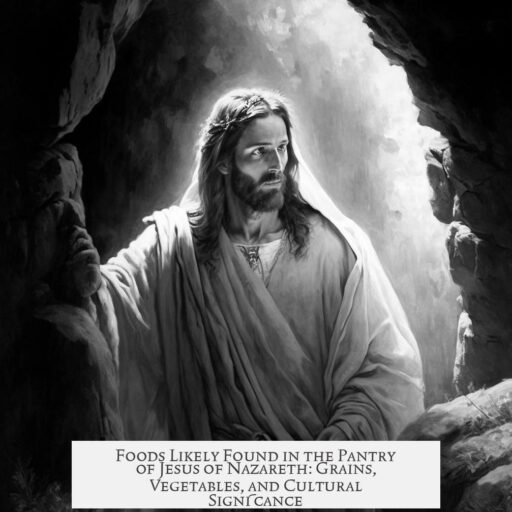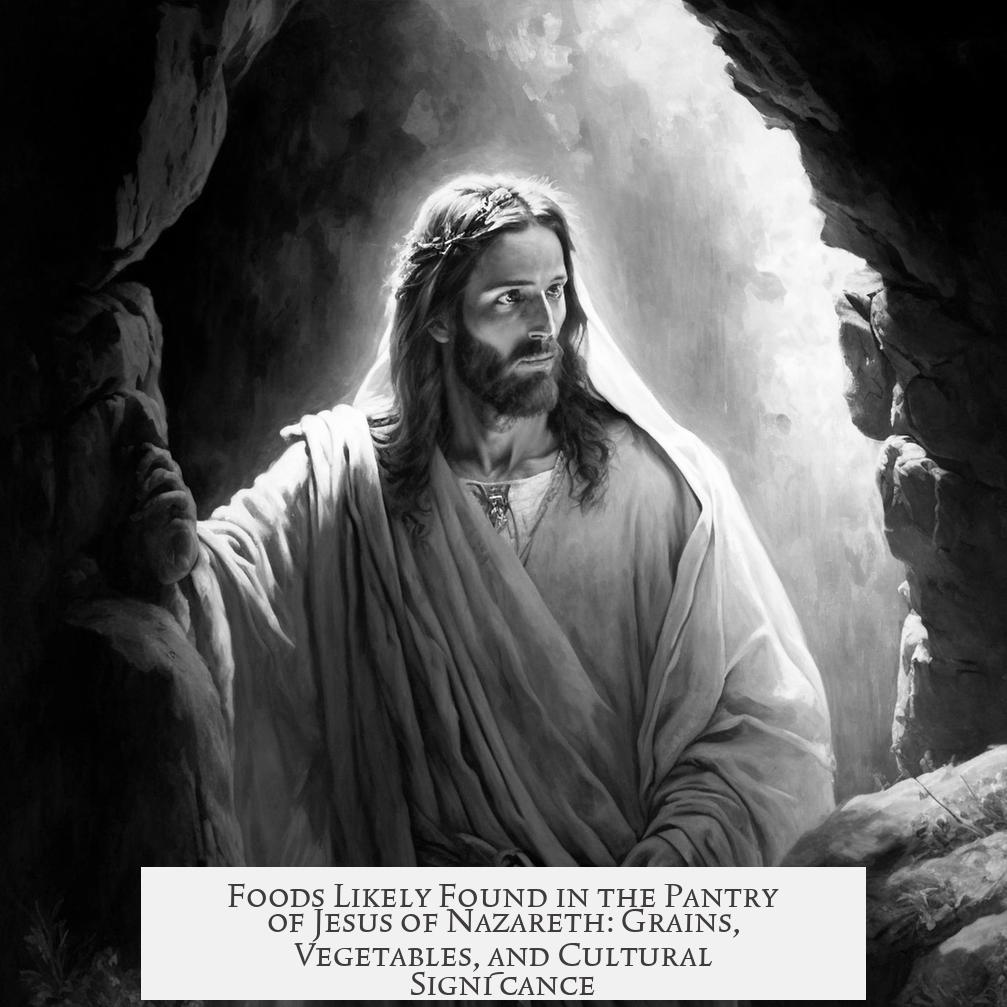Jesus of Nazareth likely consumed foods typical of a first-century Jewish diet in the Near East. His meals consisted primarily of grains, fruits, vegetables, dairy, occasional meat, and various seasonings available in his cultural and geographical context.

Grains formed the diet’s staple. Bread made from wheat or barley accompanied most meals. Grains were also used to create stews or gruels. These provided necessary energy and nutrients.
Meat was rare for everyday meals. It appeared mostly on festive or religious occasions. When consumed, lamb was common, reflecting Jewish dietary customs. Poultry, fish, and hunted game were available but less frequent. The best parts often went to guests during special events.

Dairy products were a significant part of the diet. Milk was transformed into cheese, yogurt, and butter. These helped with nutrition and preservation in the hot climate.
Fruits like olives, figs, grapes, pomegranates, dates, and melons were readily eaten, either fresh or dried. They provided sweetness and vitamins. Vegetables included cucumbers, onions, garlic, carrots, and leafy greens. Though less documented archaeologically, they were important staples.

Additional items rounded out meals. Honey served as a sweetener. Olive oil was common for cooking and flavoring. Salt, herbs, and vinegar helped season food. Occasionally, locusts or grasshoppers appeared as protein sources.
Wine might have been consumed in moderation, often during social or religious contexts. Legumes like beans and lentils, while not always explicitly noted, were likely part of the diet due to their regional prevalence.

Socioeconomic status influenced food availability. Jesus, from a modest background, probably ate simple meals consistent with the common population. Markets provided various foods, but daily life emphasized practicality and observance of ritual dietary laws.
- Staple grains: wheat and barley bread, stews
- Occasional meat: mainly lamb during feasts
- Dairy: milk, cheese, yogurt, butter
- Common fruits: olives, figs, grapes, dates
- Vegetables: cucumber, onion, garlic, carrots
- Seasonings: honey, olive oil, salt, vinegar, herbs
- Other proteins: fish, eggs, locusts
What kinds of food would Jesus of Nazareth have eaten?

Let’s cut to the chase: Jesus of Nazareth ate the typical fare of a first-century Jewish man living in the Galilee region, which mostly included grains, fruits, vegetables, dairy, and occasionally meat. That’s the nutshell version. Now, let’s unlock the pantry doors of history and smell what the ancient menus were cooking.
Wondering what historical evidence backs this up? Scholars piece together details from the Bible—which serves as a helpful but secondary source—and archaeological digs in the Near East. These digs have unveiled remnants of food and tools that tell stories about ancient diets, confirming much of what religious texts hint at.

Food as a Cultural and Religious Marker
Back then, every meal wasn’t just about filling the stomach. Food carried religious meaning and cultural identity. Consider that food acted as a social passport—what you ate marked who you were and aligned you with specific traditions and communities. Eating habits distinguished everyday living from sacred rituals, which often had special food requirements.

Picture life in a world without supermarkets or global food imports. Food wasn’t just nourishment; it was a symbol woven into daily life and faith. For Jesus, living in a heavily religious and culturally charged environment, this mattered a lot.
Grains: The Daily Staple
Grains formed the backbone of Jesus’ diet. Think wheat and barley, served fresh or roasted. These grains were ground into flour to bake various types of bread or cooked into stews and gruels. These meals were both filling and nutritious—perfect for sustaining long days walking or teaching in Galilee and Judea.
The humble bread, a symbol with spiritual significance even today, was the foundation. Jesus himself famously broke bread at meals, reinforcing how central grain was to daily life.
Meat: More of a Treat than a Staple
Meat wasn’t an everyday indulgence. It showed up mostly during festive occasions or special events. Average folks, like Jesus likely, ate meat—mainly lamb—about once a week or less.
The meat options included domesticated animals such as sheep, goats, and occasionally cattle, alongside poultry like chickens and ducks. Fish also featured significantly, given the proximity to the Sea of Galilee. Hunting provided other possibilities, but was less common for regular meals.
And yes, the best cuts of meat typically went to honored guests during feasts—social dining had its own pecking order.
Dairy and Its Cooling Sidekicks
Middle Eastern heat is no joke. To cope, milk was often turned into cheese, butter, and yogurt, which helped preserve it and offered refreshing options during hot days.
For Jesus, this dairy variety would have been familiar, as herding was common, providing access to such products. These also balanced the diet, adding calories and nutrients.
Fruit and Vegetables: Nature’s Colorful Gift
Fruits must have brightened the food scene. Figs, pomegranates, grapes, apricots, dates, apples, and olives were staples. Berries like black mulberries also featured but are less documented.
Vegetables, while less featured in texts and artifacts, played an important role. Think cucumbers, carrots, watermelon, onion, garlic, and even wild greens like dandelion and capers. These provided essential vitamins and flavors.
Seasonings, Sweeteners, and the Odd Crunch
Honey was the go-to sweetener—no sugar bowls here. Olive oil was the primary fat, crucial for cooking and flavoring.
Imagine a seasoning set consisting of salt, herbs, vinegar, and perhaps a surprise cameo by grasshoppers or locusts. Yes, those crunchy critters were eaten occasionally, not just in survival mode but as a known delicacy.
The Social Side of Meals
Food mirrored society. Nobles enjoyed more luxurious fare with frequent meat and wine. The average person, likely including Jesus, shopped at local markets when not consuming homegrown or herded foods.
Festive times meant better food—more meat, wine, and special dishes were laid out during religious or civic festivals. So, the diet varied with seasons and occasions.
Putting it Together: Jesus’ Probable Pantry
| Food Category | Examples |
|---|---|
| Fruits | Olives, Figs, Grapes, Pomegranates, Dates, Melons |
| Meat | Lamb (occasionally) |
| Dairy | Milk, Cheese, Yogurt |
| Vegetables | Cucumbers, Carrots, Onions, Garlic |
| Grains | Bread (Wheat, Barley), Gruels, Stews |
| Other | Nuts, Raisins, Eggs, Fish, Honey, Olive Oil, Wine, Herbs |
Altogether, this paints a picture of a simple but balanced diet, brimming with flavors from the crops and livestock of ancient Palestine. It was nothing extravagant, but enough to thrive and sustain a life of travel and teaching.
So, Why Does This Food Matter?
Understanding what Jesus ate helps us connect with his world on a very human level. It reveals the rhythms of daily life and social customs behind biblical stories. Plus, reflecting on his diet serves as a reminder: even the most historically iconic figures had simple meals.
Next time you enjoy some olives or bread, think about the thousands of years—and stories—behind that food.
For more detailed insight, check Oded Borowski’s ‘Eat, Drink and Be Merry: The Mediterranean Diet’ published in Near Eastern Archaeology (2004).



